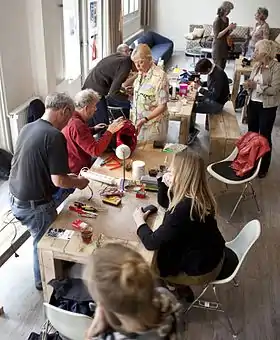Repair café
A repair café is a meeting in which people repair household electrical and mechanical devices, computers, bicycles, clothing, and other items. They are organised by and for local residents. Repair cafés are held at a fixed location where tools are available and where they can fix their broken goods with the help of volunteers.[1] The objectives are to reduce waste, to maintain repair skills and to strengthen social cohesion.[2][3][4][5][6][7]

History
The concept was devised by Martine Postma in 2009.[8] On 18 October 2009, the first Repair Café was held at Fijnhout Theater, Amsterdam-West. On 2 March 2010, the Repair Café Foundation was set up. The foundation was formed to support local groups around the world in setting up their own Repair Cafés.[9] Since then, the number of Repair Cafés has grown quickly. In March 2016 Postma registered more than 1,000 Repair Cafés worldwide, 327 in the Netherlands, 309 in Germany, 22 in the UK, 21 in the US, 15 in Canada, four Australia and one in India.[10] In January 2017 the number of Repair Cafés climbed over 1,200, in March 2018 the number reached 1,500 in 33 countries.[11]
In 2017, the first International Repair Day was announced. It is intended to be an annual event, taking place on the third Saturday of October each year.[12]
Knowledge sharing
In 2017, the Repair Café Foundation developed an online tool - the RepairMonitor - enabling volunteers to collect and sharing knowledge about repair data via the database. In March 2018, information about almost 4,000 repairs had been entered into this system, aiming to promote reparability and durability of products.
3D printing of broken parts
Some repair cafés have begun to use 3D printers for replicating broken parts.[13] Broken pieces of domestic appliances may be able to be pieced or glued back together, after which they can be scanned with a 3D scanner. Examples of 3D scanners include David Starter-Kit, 3D Systems Sense, MakerBot Digitizer, Fuel 3D, Microsoft Kinect, and Asus Xtion.[n 1] Once the physical object is scanned, the 3D model is rendered. It can be converted to a .stl or .obj format and revised using geometry processing software such as makeprintable, netfabb, MeshLab, Meshmixer, Cura, or Slic3r.[n 2] It is printed using a 3D printer client, creating a physical part using the 3D printer. The complete process takes some time to complete.
To reduce the time needed in the repair café, people might choose to use a pre-made part from a website with 3D models (skipping the scanning step),[n 3] or make the 3D model themselves by taking many photographs of the part and using something like 123D Catch, and/or choose (in the event the repair café does not have its own 3D printer) to have the 3D model made in the repair café, but printed using a 3D printer elsewhere. Alternatively a 3D printing service like Ponoko, Shapeways, and others can be used, and a person then return to the repair café to have the new part fitted to the broken equipment.
See also
- Consumer Rights Act 2015
- Bicycle cooperative – a place for bike repair
- Circular economy
- iFixit
- Hackerspace (makerspace)
- Low technology
- Men's shed
- Sharing economy
- Tool library
- Upcycling
- Magnuson–Moss Warranty Act
Notes
- Microsoft Kinect and Asus Xtion can be used together with ReconstructMe software for 3D scanning
- Cura and Slic3r have some fixup tools, despite being mainly a slicer program
- Examples of such websites are Thingiverse, CGTrader, GrabCAD, and Google 3D Warehouse
References
- Wackman, John (16 July 2013). "'Repair Café' Gets Stuff Fixed". Rethink Local website. Retrieved 9 February 2017.
- "Global Village: Warum eine neue Bewegung aus den Niederlanden Toaster und Bügeleisen repariert " Der Spiegel, 26 May 2012
- "Mehr reparieren, weniger konsumieren Westdeutscher Rundfunk, 29 July 2012
- "Repair Cafe nu ook doorgedrongen in Duitsland" heute, 26 January 2012
- "Dutch group mends broken items for free" Al Jazeera, 16 July 2012
- "Repareren is weer in" VTM, 1 December 2012
- "Repair Café naar Elzenhof" Brusselnieuws, 3 January 2013
- Sally McGrane, "An Effort to Bury a Throwaway Culture One Repair at a Time" The New York Times, 8 May 2012
- Purvis, Katherine; Card, Nell; Palmer, Lucy (17 September 2014). "How to set up your own repair café". The Guardian. London. Retrieved 14 November 2016.
- Visit a Repair Café, repaircafe.org captured archive.org on 19 March 2016
- Visit a Repair Café, repaircafe.org captured archive.org on 30 January 2017
- "Dialogues and Debates: Ugo Vallauri". Voice Magazine. Retrieved 12 September 2018.
- "Repair café maakt onvindbare wisselstukken met 3D-printer" Het Belang van Limburg